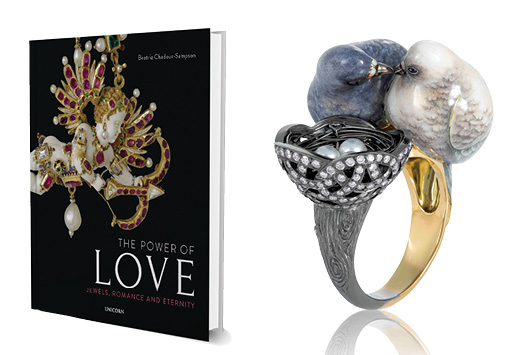
The tradition of giving a betrothal or wedding band dates back to ancient Rome, according to Beatriz Chadour-Sampson, author of
The Power of Love: Jewels, Romance and Eternity. The ring was believed to have a direct link to the heart when worn on the ring finger of the left hand. “The wedding ring was given in promise of marriage, before the actual ceremony,” she said at her September book launch in London.
In the medieval period, hidden messages were a key feature of love jewelry, she relates in the book, a well-illustrated, thoroughly researched and superbly documented account of the history of such jewels through the centuries. “The medieval period was all about love, hearts versus padlocks and all kinds of very hidden messages in jewelry in different shapes,” she tells
Rapaport Magazine.
Early Roman betrothal rings were mainly made of iron and later of gold, she says. It was not until the 15th century that diamond rings were primarily associated with marriage. However, from the earliest times, rubies or garnets were emblems of passion, diamonds or rock crystals symbolized virtue and constancy, sapphires denoted eternal love, and emeralds stood for desire and hope.
One of the strengths of the book is its focus on diamonds, which have featured increasingly in love jewelry over the centuries. Before 1725, diamonds came from India, predominantly from Golconda; they were later found in greater volumes in Brazil, and from 1867 onward, in South Africa, Chadour-Sampson explains.
Fit for royalty
The volume discusses and shows pictures of jewelry gifts from royal love affairs, including France’s Napoleon Bonaparte and Josephine, Britain’s Queen Victoria and Albert, and the latter pair’s successors Edward VII and Princess Alexandra.
In the 20th century, the book highlights love jewelry gifted to Wallis Simpson, duchess of Windsor, by her husband Edward VIII, notably pieces from Van Cleef & Arpels and Cartier. Other celebrities whose gifted jewels make an appearance range from Hollywood actresses Grace Kelly and Elizabeth Taylor to Victoria Beckham, who has received 14 engagement rings from her soccer-star husband David. Taylor recalled that actor Richard Burton, her two-time husband, would give her spectacular gifts for birthdays and Christmas but also used any excuse to proffer a piece of jewelry: “He’d give me ‘It’s Tuesday I love you,’” the book quotes her as saying.
Also featured in the book are the Wheels of Love earrings by Hong Kong-based jewelry artist Wallace Chan, made with diamonds, emeralds, rubies, opals and lapis lazuli. Chan was inspired by the lyrics of an Emmylou Harris song: “The wheels of love turn around and around.”
The jewelry adorning royalty and aristocracy, and more recently celebrities, has contributed to trends in commercial designs, Chadour-Sampson points out. However, she remarks, “this is nothing to do with love: It is a general ‘wanting to be like the others.’”
In terms of celebrity influence, colored gemstones lead the way in love jewelry. “If you look at celebrities, you find that colored diamonds and all kinds of colored stones like pink tourmalines and pink sapphires come into it as well,” Chadour-Sampson says.
Changing traditions
The Power of Love explores how love jewelry is changing in the 21st century. Men’s wedding rings are increasingly in demand, for instance. The book also highlights marriage rings featuring the couple’s fingerprints or DNA.
Munich-based artist jeweler Gerd Rothmann is one example. On his ring bezels, he uses casts of the couple’s fingerprints so each can wear the other’s print. The Biojewellery project, meanwhile, offers a glimpse into the future of this jewelry category. Designer Nikki Stott and medical researcher Dr. Ian Thompson developed the initiative several years ago, creating rings with samples of cells from the engaged couple’s teeth. The cells would be grown into bone tissue in a laboratory and then combined with precious metals to form the ring, enabling the couple to carry each other’s tissue on their fingers.
“Everything goes these days,” Chadour-Sampson comments.
While the traditional notion that partners will stay together forever is being questioned today, what does not seem to be in dispute is the continuing appeal of jewelry to communicate and celebrate love in all its forms.
The Power of Love: Jewels, Romance and Eternity was released by Unicorn on September 2.
Image: Ilgiz FazulzyanovArticle from the Rapaport Magazine - November 2019. To subscribe click here.